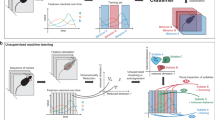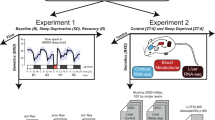Abstract
A recent perspective discussed high-throughput behavioral analysis using mice, giving the overall impression that this area is lagging behind in neuroscience and biomedical research. Not only are we more optimistic about the current state of the art in behavioral neuroscience and its promise, but we also have reservations about whether high-throughput analysis is always an appropriate goal for most behavioral studies. We argue that behavioral studies should be carried out with clear goals and more regard to the intellectual context in which they have developed. In addition, behavioral studies can be performed quite easily, but this does not ensure the required validity or reliability of the particular tests used. Finally, high throughput may not always be an appropriate goal. We discuss the role of automated data collection and unique data-mining algorithms, and the question of the ethological relevance of behavioral tests.
This is a preview of subscription content, access via your institution
Access options
Subscribe to this journal
Receive 12 print issues and online access
$209.00 per year
only $17.42 per issue
Buy this article
- Purchase on Springer Link
- Instant access to full article PDF
Prices may be subject to local taxes which are calculated during checkout
Similar content being viewed by others
References
Tecott, L.H. & Nestler, E.J. Neurobehavioral assessment in the information age. Nat. Neurosci. 7, 462–466 (2004).
Gibbs, R.A. et al. Genome sequence of the Brown Norway rat yields insights into mammalian evolution. Nature 428, 493–521 (2004).
Crawley, J.N. What's Wrong with My Mouse? (Wiley, New York, 2000).
Bucan, M. & Abel, T. The mouse: genetics meets behaviour. Nat. Rev. Genet. 3, 114–123 (2002).
Morris, R.G.M. & Kennedy, M.B. The Pieran Spring. Curr. Biol. 2, 511–514 (1992).
Morris, R.G.M. Spatial localisation does not require the presence of local cues. Learning Motivation 12, 239–260 (1981).
Galea, L.A., Kavaliers, M. & Ossenkopp, K.P. Sexually dimorphic spatial learning in meadow voles Microtus pennsylvanicus and deer mice Peromyscus maniculatus. J. Exp. Biol. 199 (Pt 1), 195–200 (1996).
Martin, S.J., Grimwood, P.D. & Morris, R.G. Synaptic plasticity and memory: an evaluation of the hypothesis. Annu. Rev. Neurosci. 23, 649–711 (2000).
Steele, R.J. & Morris, R.G. Delay-dependent impairment of a matching-to-place task with chronic and intrahippocampal infusion of the NMDA-antagonist D-AP5. Hippocampus 9, 118–136 (1999).
Nakazawa, K. et al. Requirement for hippocampal CA3 NMDA receptors in associative memory recall. Science 297, 211–218 (2002).
Wolfer, D.P. & Lipp, H.P. Dissecting the behaviour of transgenic mice: is it the mutation, the genetic background, or the environment? Exp. Physiol. 85, 627–634 (2000).
Wahlsten, D., Rustay, N.R., Metten, P. & Crabbe, J.C. In search of a better mouse test. Trends Neurosci. 26, 132–136 (2003).
Chen, G. et al. A learning deficit related to age and β-amyloid plaques in a mouse model of Alzheimer's disease. Nature 408, 975–979 (2000).
Morgan, D. et al. A β peptide vaccination prevents memory loss in an animal model of Alzheimer's disease. Nature 408, 982–985 (2000).
Crabbe, J.C. et al. Strain differences in three measures of ethanol intoxication in mice, the screen, dowel and grip strength tests. Genes Brain Behav. 2, 201–213 (2003).
Crabbe, J.C. et al. Genotypic differences in ethanol sensitivity in two tests of motor incoordination. J. Appl. Physiol. 95, 1338–1351 (2003).
Rustay, N.R., Wahlsten, D. & Crabbe, J.C. Assessment of genetic susceptibility to ethanol intoxication in mice. Proc. Natl. Acad. Sci. USA 100, 2917–2922 (2003).
Crabbe, J.C., Metten, P., Cameron, A.J. & Wahlsten, D. Genetics of alcohol intoxication in inbred mice. Neurosci. Biobehav. Rev. (in press).
Kale, A., Amende, I., Meyer, G.P., Crabbe, J.C. & Hampton, T.G. Ethanol's effects on gait dynamics in mice investigated by ventral plane videography. Alcoholism Clin. Exp. Res. (in press).
Rodgers, R.J. Animal models of 'anxiety': where next? Behav. Pharmacol. 8, 477–496 (1997).
Wahlsten, D., Metten, P. & Crabbe, J.C. A rating scale for wildness and ease of handling laboratory mice: results for 21 inbred strains tested in two laboratories. Genes, Brain Behav. 2, 71–79 (2003).
Kafkafi, N. et al. SEE locomotor behavior test discriminates C57BL/6J and DBA/2J mouse inbred strains across laboratories and protocol conditions. Behav. Neurosci. 117, 464–477 (2003).
Kafkafi, N. et al. Darting behavior: a quantitative movement pattern designed for discrimination and replicability in mouse locomotor behavior. Behav. Brain Res. 142, 193–205 (2003).
Drai, D. & Golani, I. SEE: a tool for the visualization and analysis of rodent exploratory behavior. Neurosci. Biobehav. Rev. 25, 409–426 (2001).
Clayton, N.S. & Krebs, J.R. Memory in food-storing birds: from behaviour to brain. Curr. Opin. Neurobiol. 5, 149–154 (1995).
Gerlai, R. Gene targeting in neuroscience: the systemic approach. Trends Neurosci. 19, 188–189 (1996).
Acknowledgements
We thank T. Phillips for comments. This work was funded by grants from the Department of Veterans Affairs and the National Institutes of Health, and by MRC Innovation and Programme Grants and an E.U. Framework V Grant.
Author information
Authors and Affiliations
Corresponding author
Ethics declarations
Competing interests
The authors declare no competing financial interests.
Rights and permissions
About this article
Cite this article
Crabbe, J., Morris, R. Festina lente: Late-night thoughts on high-throughput screening of mouse behavior. Nat Neurosci 7, 1175–1179 (2004). https://doi.org/10.1038/nn1343
Received:
Accepted:
Published:
Issue Date:
DOI: https://doi.org/10.1038/nn1343
This article is cited by
-
Noninvasive Tracking of Every Individual in Unmarked Mouse Groups Using Multi-Camera Fusion and Deep Learning
Neuroscience Bulletin (2023)
-
Behavioral models in psychopathology: epistemic and semantic considerations
Behavioral and Brain Functions (2019)
-
AHCODA-DB: a data repository with web-based mining tools for the analysis of automated high-content mouse phenomics data
BMC Bioinformatics (2017)
-
Systematic heterogenization for better reproducibility in animal experimentation
Lab Animal (2017)
-
SynapticDB, Effective Web-based Management and Sharing of Data from Serial Section Electron Microscopy
Neuroinformatics (2011)



